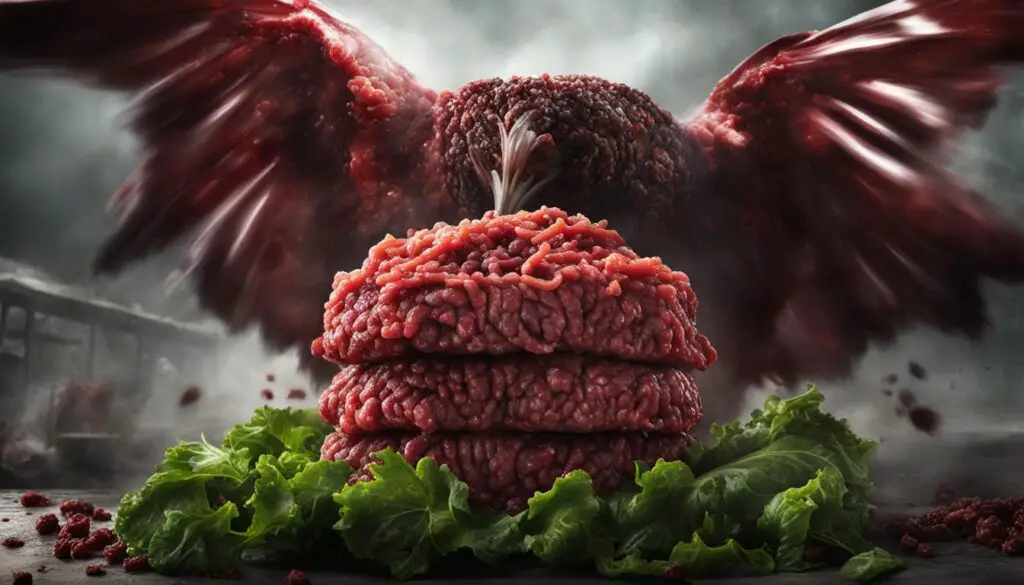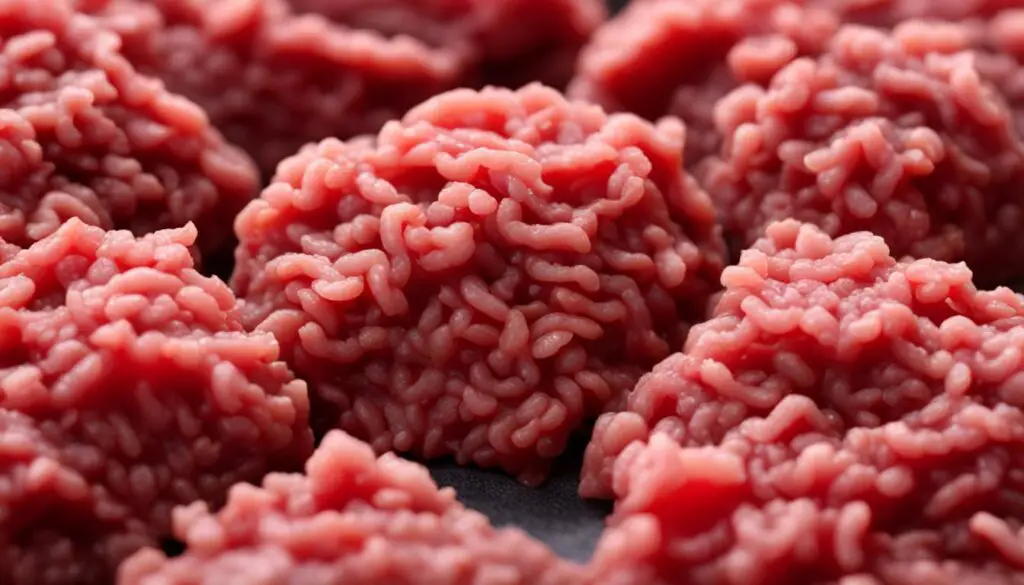Ground beef is a staple ingredient in many dishes, but it can easily spoil and pose risks to our health. Being able to identify the signs of spoiled ground beef is essential in order to avoid consuming contaminated meat and potential food poisoning.
One of the key indicators of bad ground beef is its smell. Fresh ground beef typically has a subtle, neutral odor. However, when ground beef goes bad, it develops a distinct, putrid smell that is unpleasant and easily recognizable.
Key Takeaways:
- Ground beef that has a foul, putrid smell is likely spoiled and should be discarded.
- Fresh ground beef has a barely perceptible odor, while spoiled ground beef has a distinct and unpleasant smell.
- Properly handling and storing ground beef can help prevent spoilage and the growth of harmful bacteria.
- It is important to differentiate between expiration dates and sell-by dates when determining if ground beef is safe to consume.
- When in doubt, it is always safer to discard ground beef that shows signs of spoilage to avoid the risk of foodborne illness.
Why Does Ground Beef Spoil Faster than Steak
Ground beef spoils faster than steak or larger cuts of meat due to its increased surface area exposed to air during the grinding process. This increased exposure provides more space for spoilage organisms to attach to the meat. Both spoilage bacteria and pathogenic bacteria can affect ground beef, causing it to lose quality, develop a bad odor and taste, and potentially lead to food poisoning.
Spoilage bacteria are responsible for the deterioration of food, leading to changes in appearance, texture, and odor. These bacteria break down proteins, fats, and carbohydrates present in ground beef, resulting in the production of compounds that contribute to off-flavors and unpleasant smells.
Pathogenic bacteria, on the other hand, are harmful bacteria that can cause illness when consumed. Examples of pathogenic bacteria that can contaminate ground beef include Salmonella and E. coli. These bacteria can enter the meat during the grinding process or through cross-contamination from other sources. If ground beef is not properly handled, cooked, or stored, these bacteria can multiply and pose a risk to consumers.
Therefore, it is important to handle and store ground beef properly to prevent spoilage and the growth of harmful bacteria. This includes ensuring that ground beef is purchased from reliable sources, stored at appropriate temperatures, cooked to the recommended internal temperature, and consumed within the recommended timeframes.
To further understand the differences between ground beef and steak, let’s compare them in a table:
| Comparison | Ground Beef | Steak |
|---|---|---|
| Surface Area | Increased surface area due to grinding process | Smaller surface area compared to ground beef |
| Exposure to air | More exposure to air, making it more susceptible to spoilage | Less exposure to air, reducing the risk of spoilage |
| Texture | Minced and mixed texture | Firm texture with intact muscle fibers |
| Cooking Time | Cooks faster due to smaller pieces | Requires longer cooking time for desired tenderness |
By understanding the factors that contribute to the spoilage of ground beef and the differences between ground beef and steak, consumers can make informed choices when handling and consuming meat products.
Signs of Spoiled Ground Beef: Color Changes
Fresh raw ground beef is typically red in color, thanks to the presence of oxymyoglobin, a pigment formed when the protein myoglobin reacts with oxygen. However, the color of ground beef can change due to various factors, including temperature, light exposure, microbial growth, and the amount of oxygen it is exposed to.
It’s important to note that the interior of raw ground meat may appear greyish brown, which is a result of a lack of oxygen exposure and is not an indication of spoilage. However, if the exterior of the ground beef has turned brown or grey, it may suggest spoilage and should be discarded to avoid any potential health risks.
| Color Change | Implications |
|---|---|
| Brown or grey on the outside | Indicates potential spoilage |
| Fuzzy blue, grey, or green spots on cooked ground beef | Indicates mold spoilage |
When cooking ground beef, it’s important to check for any abnormal color changes and ensure that the meat is cooked thoroughly to kill any potential bacteria that may be present.

The image above demonstrates some common color changes that may occur in ground beef, indicating spoilage or mold growth.
Texture Changes in Spoiled Ground Beef
Fresh ground beef should have a relatively firm consistency that breaks apart easily when squeezed. This firmness is a sign of freshness and quality. However, if the ground beef feels sticky or has a slimy texture, whether when raw or cooked, it may indicate the presence of spoilage bacteria.
This slimy texture is a clear indication that the meat has started to spoil and should be discarded. Consuming ground beef with a slimy texture can pose a risk of foodborne illness, as it may contain harmful bacteria that can cause digestive issues and other health problems.
To prevent the spread of bacteria, it is crucial to wash your hands thoroughly with soap and water after handling raw meat. This simple hygiene practice helps reduce the risk of contamination. Additionally, make sure to clean any utensils, cutting boards, or surfaces that come into contact with raw ground beef to maintain a safe cooking environment.
By being aware of the texture changes in ground beef and taking the necessary precautions, you can ensure the quality and safety of your meals.
Signs of Spoiled Ground Beef
| Sign | Indication |
|---|---|
| Sticky or slimy texture | Presence of spoilage bacteria |
| Color change to brown or grey | Possible spoilage |
| Fuzzy blue, grey, or green spots on cooked meat | Mold spoilage |
| Unpleasant odor | Likely spoilage |
Smell Test for Bad Ground Beef
The smell test is a simple and effective way to determine whether ground beef has gone bad. While fresh ground beef may have a barely perceptible smell, spoiled ground beef will have a tangy, putrid odor that is distinct from fresh meat. This change in smell is caused by the increased growth of spoilage bacteria, which can affect the flavor as well.
It is important to note that pathogenic bacteria cannot be smelled, so even if the meat doesn’t have a funny scent but shows signs of spoilage in color or texture, it should still be discarded.
To conduct a smell test, follow these steps:
- Open the package of ground beef and take a close sniff.
- If the meat smells fresh or slightly metallic, it is likely safe to use.
- If the meat has a tangy, rancid meat smell or a putrid ground beef scent, it is spoiled and should not be consumed.
- Dispose of the spoiled meat properly to prevent any accidental consumption.
Remember, trust your nose! If the smell seems off and unpleasant, it’s better to be safe and discard the meat.
In case you’re still unsure, here’s an image to help you understand the difference:

Checking the Expiration Date of Ground Beef
When purchasing ground beef, it’s essential to check the expiration date to ensure its freshness and quality. Ground beef packages typically display both a sell-by date and an expiration date. While the sell-by date indicates how long the meat can be displayed for sale, the expiration date, also known as the “best before” date, indicates the point when the product will likely start going bad.
It is important to note that ground beef can be refrigerated and safely consumed up to 2 days past the sell-by date. However, it is generally advised not to consume ground beef past its expiration date unless it has been properly frozen. Freezing ground beef can extend its shelf life up to 4 months, allowing you to enjoy it at a later time without compromising its quality and safety.
By checking the expiration date, you can ensure that you are consuming ground beef that is fresh, safe, and at its best quality.
Ground Beef Shelf Life
| Ground Beef | Refrigerated Shelf Life (Past Sell-By Date) | Frozen Shelf Life (Past Expiration Date) |
|---|---|---|
| Fresh | 2 days | Up to 4 months |
Side Effects of Consuming Spoiled Ground Beef
Consuming spoiled ground beef can have severe consequences on your health, leading to food poisoning. This is primarily due to the presence of harmful bacteria such as Salmonella and Shiga toxin-producing E. coli (STEC). These bacteria can contaminate ground beef during the production process or improper storage conditions, posing a significant risk to consumers.
Foodborne illness caused by these harmful bacteria can result in a range of symptoms, including:
- Fever: An elevated body temperature is a common symptom of food poisoning. It may indicate that your body is fighting off an infection caused by the harmful bacteria present in the spoiled ground beef.
- Vomiting: The ingestion of contaminated ground beef can stimulate the body’s natural defense mechanisms, resulting in nausea and vomiting as the body attempts to eliminate the harmful substances.
- Stomach Cramps: Abdominal discomfort and cramps are frequently experienced by individuals who have consumed spoiled ground beef. This can be attributed to the body’s attempt to expel harmful bacteria or toxins.
- Diarrhea: Diarrhea is a common symptom of foodborne illness. It can range from mild to severe and may be accompanied by blood in the stool, particularly in cases of infection with STEC bacteria.
It is important to note that symptoms of foodborne illness may not appear immediately after consuming spoiled ground beef. They can take several days to manifest, which can make it difficult to trace the exact cause of the illness back to the contaminated meat.
To reduce the risk of food poisoning, it is crucial to handle and cook ground beef properly. Thoroughly cooking ground beef to a minimum internal temperature of 160°F (71°C) can destroy harmful bacteria and ensure the safety of the meat. It is also necessary to follow proper hygiene practices, such as washing hands and utensils thoroughly after handling raw ground beef, to prevent the spread of bacteria in the kitchen.

Proper Handling and Storage of Ground Beef
When it comes to ground beef, safe handling and proper storage are key to preventing food poisoning. Follow these guidelines to ensure the safety of your ground beef:
- Buy fresh and handle with care: Purchase your ground beef last and head directly home to minimize the time it is left unrefrigerated. Choose packages that are cold to the touch and in good condition.
- Prevent cross-contamination: Keep raw ground beef separate from other foods in your cart to avoid cross-contamination. This helps prevent the spread of harmful bacteria.
- Refrigerate promptly: Refrigerate or freeze ground beef within 2 hours of purchase. Ensure that your refrigerator temperature is set below 40°F (4°C) to maintain its freshness.
- Thaw safely: If you have frozen ground beef, thaw it in the refrigerator overnight. This ensures gradual thawing and helps maintain the quality of the meat.
- Handle leftovers carefully: Refrigerate any leftover cooked ground beef within 2 hours of cooking. Properly storing leftovers can help prevent the growth of bacteria.
- Practice good hygiene: Always wash your hands thoroughly with soap and water after handling raw ground beef. Clean kitchen counters, utensils, and cutting boards to prevent the spread of bacteria.
By following these safe handling and storage practices, you can reduce the risk of food poisoning and ensure that your ground beef remains fresh and safe to consume.
FAQ – What Does Bad Ground Beef Smell Like?
When it comes to detecting whether ground beef has gone bad, the sense of smell plays a crucial role. Spoiled ground beef has a distinct and pungent odor that is easily distinguishable from the barely perceptible smell of fresh ground beef. While safe-to-eat ground beef typically has little to no noticeable smell, spoiled meat develops a putrid scent that is hard to miss.
If ground beef emits a noticeable, pungent smell that is different from its usual aroma, it is likely spoiled and should be discarded.
However, it’s important to note that ground beef that has a slight scent of iron is still safe to consume. This faint aroma is a natural characteristic of fresh ground beef and doesn’t indicate spoilage or food safety risks.
On the other hand, a sour or rancid odor is a clear indicator of spoilage, and the ground beef should not be consumed.

Visualizing the difference between fresh and spoiled ground beef can help determine its quality and prevent the risk of foodborne illnesses.
Signs of Fresh and Spoiled Ground Beef
| Signs | Fresh Ground Beef | Spoiled Ground Beef |
|---|---|---|
| Color | Bright red | Brown or gray on the outside |
| Texture | Firm consistency | Sticky or slimy texture |
| Smell | Barely perceptible | Pungent, putrid odor |
| Expiration Date | Safely consumed within the stated timeframe | Should not be consumed past its expiration date |
FAQ – Can Ground Beef Smell a Little but Not Be Expired?
It’s common for ground beef to have a slight aroma of iron, which is completely normal and doesn’t necessarily indicate spoilage. However, if ground beef is nearing its expiration date, you may notice a slightly more noticeable smell than usual. But don’t worry, as long as it doesn’t have a pungent odor, the ground beef is still safe to consume.
It’s important to differentiate between the expiration date and the sell-by date on the package. Ground beef can typically be safely consumed up to 2 days past the sell-by date if it has been stored properly. However, it is advised not to eat ground beef past its expiration date, unless it has been appropriately frozen. Freezing ground beef can extend its shelf life for up to 4 months, ensuring its safety for future consumption.
Remember, a slight aroma of fresh ground beef is normal, but any pungent or putrid odor is a clear sign of spoilage, and the ground beef should be discarded. Trust your senses and don’t take any chances when it comes to the freshness of your meat.
FAQ – Is It Safe to Cook Grey Ground Beef?
The color of ground beef can vary, and the presence of grey areas in the meat is normal and safe to cook with. While the outer portion of ground beef may be red or pink, the inner portion may appear grey or brown due to a lack of oxygen exposure. This color change is harmless as long as the meat doesn’t have any signs of spoilage such as an off smell or slimy texture. However, ground beef that is completely grey or brown all over is a clear sign of spoilage and should not be cooked or consumed.

Conclusion
Properly identifying spoiled ground beef is crucial to avoid food poisoning and ensure the safety of the meals we consume. Ground beef is more susceptible to spoilage due to its increased surface area exposed to air during the grinding process. Color changes, texture changes, smell, and expiration dates are all important signs to look out for when determining if ground beef has gone bad. It is important to handle and store ground beef properly to prevent spoilage and the growth of harmful bacteria. When in doubt, it is always safer to discard ground beef that shows signs of spoilage to avoid the risk of foodborne illness.
By paying attention to the color of ground beef, you can easily spot any unusual changes that may indicate spoilage. Fresh raw ground beef should be red, but if it has turned brown or grey on the outside, it is likely spoiled. Texture changes, such as a slimy or sticky consistency, can also indicate the presence of spoilage bacteria. Additionally, conducting a simple smell test can help determine if ground beef has gone bad. Fresh ground beef typically has a faint smell, while spoiled ground beef will have a pungent, putrid odor that is distinct from fresh meat.
It is important to be mindful of expiration dates and handle ground beef with care. Check both the sell-by date and the expiration date on the package, and consume ground beef within the recommended time frames. Proper handling and storage are also essential to prevent spoilage. Refrigerate or freeze ground beef within two hours of purchase, and thaw frozen beef in the refrigerator to maintain its quality. By following these guidelines and being vigilant of the signs of spoiled ground beef, you can protect yourself and your loved ones from potential foodborne illnesses.
FAQ
What does bad ground beef smell like?
Spoiled ground beef will have a tangy, putrid odor that is distinct from fresh meat.
Can ground beef smell a little but not be expired?
Fresh ground beef may have a barely perceptible smell, but if there is a noticeable, pungent odor, it is likely spoiled and should be discarded.
Is it safe to cook grey ground beef?
While the inner portion of ground beef may appear grey or brown due to a lack of oxygen exposure, as long as the meat doesn’t have any signs of spoilage such as an off smell or slimy texture, it is safe to cook.

